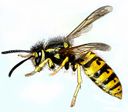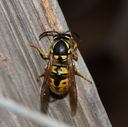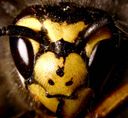German Yellowjacket
Vespula germanica
Classification
- Phylum: Arthropoda
- Subphylum: Hexapoda
- Class: Insecta
- Order: Hymenoptera
- Superfamily: Vespoidea
- Family: Vespidae
- Subfamily: Vespinae
- Genus: Vespula
- Species: germanica
Pronunciation
How to pronounce Vespula germanica: /vɛsˈpuːla gɛrˈmaːnɪka/
These audio files are automatically generated. While they are not always 100% accurate, they are a good starting point.
Images






Summary
Vespula germanica, commonly known as the German yellowjacket, is a socially organized wasp native to Europe, Northern Africa, and temperate Asia, which has successfully established populations in various other regions. They show unique behavioral traits and have significant ecological impacts, particularly in areas where they are invasive.
Physical Characteristics
Body length of 13 mm; workers 12-15 mm; forewing length for workers is 7.5–12.0 mm, queen 13.0–15.0 mm, drone (male) 12.0–13.0 mm. Characteristic colors of black and yellow; differs from common wasp (V. vulgaris) by presence of three tiny black dots on clypeus (only applicable to workers).
Identification Tips
Observe whether the wasp is a worker, queen, or drone before identifying specifics between V. vulgaris and V. germanica. Gastral patterns are highly variable and not reliable for identification. The normally unbroken black mark on the clypeus of V. vulgaris can sometimes appear broken, complicating identification.
Habitat
Colonies typically built underground or in artificial structures like attics; significant number found in soil.
Distribution
Native to Europe, Northern Africa, and temperate Asia. Introduced and established in North America, South America (Argentina and Chile), Australia, South Africa, and New Zealand. First recorded in New York in the 1890s and in parts of Canada in the 1960s and 1970s.
Diet
Opportunistic scavengers and predators; feed on carrion, live arthropods, fruit, honeydew, processed human food, and garbage.
Life Cycle
A single queen starts a nest in spring, leading to a large colony size in summer, followed by a slowdown in growth and production of new queens and males in the fall. New queens hibernate while the colony collapses.
Reproduction
Queens are typically polyandrous, mating with one to seven males, while workers are unable to mate but can produce haploid males from unfertilized eggs in the presence of a queen.
Ecosystem Role
As predators and scavengers, V. germanica impacts indigenous arthropod populations and can outcompete native species, posing threats to ecosystem balance.
Economic Impact
Considered a pest in areas outside its native range due to significant ecological impacts and resource competition with native species.
Health Concerns
N/A
Evolution
V. germanica belongs to the genus Vespula, which includes social wasps found throughout the Northern Hemisphere. These wasps are often confused with other genera, and share characteristics with V. vulgaris and V. pensylvanica.
Misconceptions
Often mistakenly referred to as paper wasps due to their nest construction, which is different from true paper wasps belonging to the subfamily Polistinae.
Tags
- Vespula
- yellowjacket
- invasive species
- wasp
- pest control